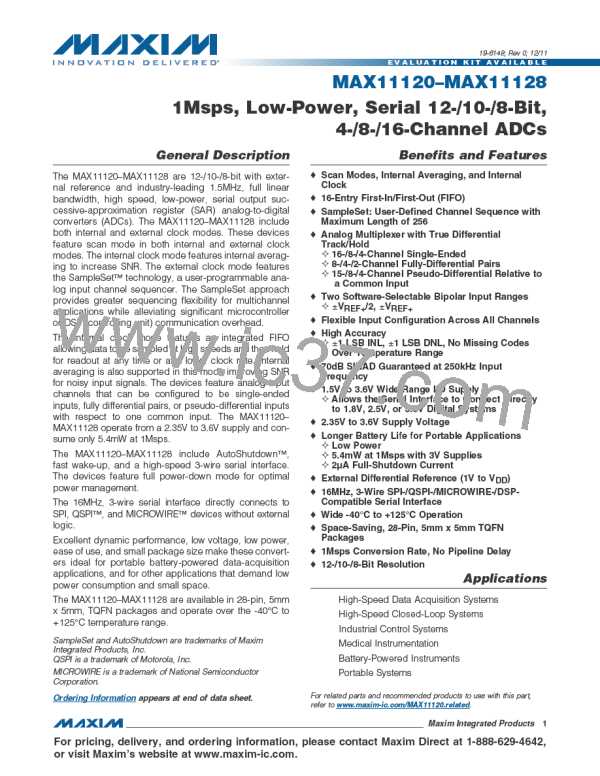MAX11120–MAX11128
1Msps, Low-Power, Serial 12-/10-/8-Bit,
4-/8-/16-Channel ADCs
Total Harmonic Distortion
Total harmonic distortion (THD) is expressed as:
Definitions
Integral Nonlinearity
Integral nonlinearity (INL) is the deviation of the values
on an actual transfer function from a straight line. This
straight line can be either a best-straight-line fit or a line
drawn between the end points of the transfer function,
once offset and gain errors have been nulled. The static
linearity parameters for the MAX11120–MAX11128 are
measured using the end-points method.
2
2
2
2
5
V
+ V + V + V
3 4
2
THD = 20 × log
V
1
where V is the fundamental amplitude, and V through V
5
are the amplitudes of the 2nd- through 5th-order harmonics.
1
2
Spurious-Free Dynamic Range
Spurious-free dynamic range (SFDR) is the ratio of the
RMS amplitude of the fundamental (maximum signal
component) to the RMS value of the next largest distor-
tion component.
Differential Nonlinearity
Differential nonlinearity (DNL) is the difference between
an actual step width and the ideal value of 1 LSB. A DNL
error specification of 1 LSB or less guarantees no miss-
ing codes and a monotonic transfer function.
Full-Power Bandwidth
Full-power bandwidth is the frequency at which the input
signal amplitude attenuates by 3dB for a full-scale input.
Signal-to-Noise Ratio
Signal-to-noise ratio is the ratio of the amplitude of the
desired signal to the amplitude of noise signals at a
given point in time. The larger the number, the better. The
theoretical minimum analog-to-digital noise is caused by
quantization error and results directly from the ADC’s
resolution (N bits):
Full-Linear Bandwidth
Full-linear bandwidth is the frequency at which the sig-
nal-to-noise plus distortion (SINAD) is more than 68dB.
Intermodulation Distortion
Any device with nonlinearities creates distortion products
when two sine waves at two different frequencies (f1 and
f2) are input into the device. Intermodulation distortion
(IMD) is the total power of the IM2 to IM5 intermodulation
products to the Nyquist frequency relative to the total
input power of the two input tones, f1 and f2. The indi-
vidual input tone levels are at -6dBFS.
SNR = (6.02 x N + 1.76) dB
In reality, there are other noise sources besides quantiza-
tion noise, including thermal noise, reference noise, clock
jitter, etc. Therefore, SNR is computed by taking the ratio
of the RMS signal to the RMS noise, which includes all
spectral components minus the fundamental, the first five
harmonics, and the DC offset.
���������������������������������������������������������������� Maxim Integrated Products 38

 MAXIM [ MAXIM INTEGRATED PRODUCTS ]
MAXIM [ MAXIM INTEGRATED PRODUCTS ]